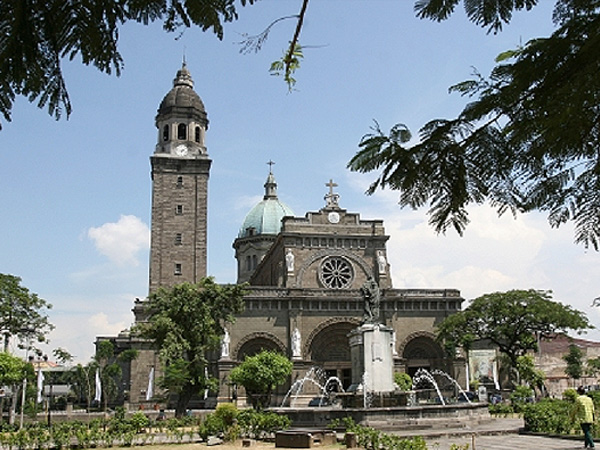The Manila Cathedral, like Pope Francis, has humble start
“The story of the Manila Cathedral is not only a story of the Church, it is also a story of Intramuros, a story of Manila, a story of the Philippines. Manila Cathedral is a time narrative; it is about ruins and ravages, rising and restorations. As its pineapple finials powerfully symbolize, Manila Cathedral represents life cycle; its rich history is a reference to trails and timelines that call for a dynamic continuance.” -manilacathedral.ph
MANILA, Philippines – Dubbed as the Mother of all Churches, Cathedrals and Basilicas, the Manila Cathedral will be hosting the third leader of the Roman Catholic Church to visit the country. Pope Francis will hold his first Mass in the Philippines at the Manila Cathedral on January 16.
‘The mother of all Churches, Cathedrals and Basilicas’
Being a mother gives a woman strength she didn’t know she had. True to its title, the Cathedral has shown strength by continuously rising after being crushed to the ground by wars, earthquakes, typhoons.
“This is the church that refused to be buried,” Luis Cardinal Tagle once said.
The church has stood the test of time, spanning four centuries.
It was first built in 1581 by Fray Bishop Domingo de Salazar out of wood, bamboo and nipa, two years after Pope Gregory XIII issued in Rome the Papal Bull that established the Diocese of manila.
Since its construction in 1581, the Cathedral has been damaged or totally destroyed several times.
* In 1583, it was destroyed by a fire that razed the city when a candle fell on the catafalque during the funeral mass for Governor General Gonzalo Ronquillo. It was rebuilt using the same materials of nipa, bamboo and wood and then renovated in 1587.
* In 1588, it was destroyed by a hurricane. Restoration of the Cathedral immediately started and lasted for six years (1594).
* The Cathedral was damaged by an earthquake in 1599.
* Still struggling from the damage, another earthquake and a typhoon in 1600 has reduced the Cathedral in a miserable condition.
* On August 1, 1621, an earthquake caused serious damage on the cathedral’s walls, columns and roofs.
* In 1645, it again was destroyed by an earthquake that lasted for five days. The earthquake was so strong that the cathedral was reduced to just a memory.
* In 1761, a storm damaged the Cathedral’s roof.
* In 1852, it was damaged by an earthquake.
* An earthquake in 1863 destroyed the church and with its destruction buried members of the Cathedral chapter and choir boys as well as attendees. It took three days to retrieve the bodies of the victims.
* It was again damaged by an earthquake in 1880.
Despite all the tragedies it has witnessed, the love of the church, passion of its Archbishops and generous heart of the people has helped rebuilt and restored the Cathedral to its former glory or in fact even better.
Significant events
Most of the people would probably remember the wedding of a once very popular love-team.
But there is more. The church has been a witness to history. Some of the significant events that happened at the church are the following:
* First Synod was held in 1582 attended by 90 ecclesiastical and religious persons and six captains where discussed among others, the teaching of catechism in the native dialect and the declaration of human rights of both native Christians and non-Christians.
* In 1907, a significant celebration was held to commemorate the Golden Jubilee of the Proclamation of the Dogma of the Immaculate Conception.
* Special rites were also performed in the cathedral to observe the First national Eucharistic congress held on December 11-15, 1929.
* 33rd International Eucharistic Congress held on February 3-7, 1937.
* The cathedral also witnessed the Te Deum for the safe arrival of Calvo and Arnaiz, the first Spanish aviators who flew from Spain to Manila.
* Special mass to mark the occasion of the inauguration of the Philippine Commonwealth in 1935.
* Pope Paul VI made an apostolic visit and celebrated mass in the Cathedral in 1970.
The Cathedral became a Basilica through Saint John Paul II when he visited the country in 1981. After celebrating a mass at the Manila Cathedral, he told then Jaime Cardinal Sin that he wanted it to become a Basilica.
Monsignor Nestor Cerbo, the Cathedral’s rector said how it became a Basilica was very special.
“Others became a Basilica because they petitioned for it, ours came on a silver platter,” he said.
Being the mother of all churches, cathedrals and basilicas, Cerbo said “we would not wonder why the Pope comes here every time he visits [the Philippines],” he said.
Like Pope Francis who had his humble beginnings in Argentina, the Manila Cathedral also had a humble start, was tested by time and instead of crumbling, it metamorphosed to become the premier Basilica. Both a beacon of hope and inspiration for a country marred with controversies and ravaged by disasters.
